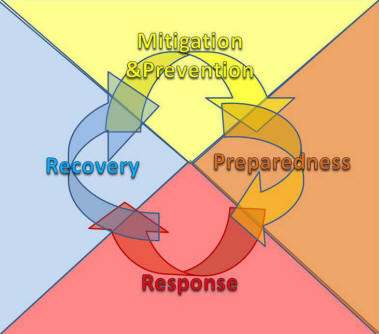|
Forward
In 2001 the
Kentucky
Center for School Safety along with the
Kentucky Department of Education, local school
district personnel, state and local law enforcement
and various response agencies developed an emergency
management planning guide or template in an effort
to assist school districts (along with their
schools) to consistently develop their emergency
operations plans. Since 2001 there have been many
changes to the school safety and community landscape
necessitating us to review and subsequently update
this document. We have again enlisted the expertise
of many partnering agencies, local school district
personnel and community organizations to guide us in
this effort. The result is a planning document for
school districts, schools and school communities
that provides a focus on an “all hazards
approach” and building the plan upon four
distinct principles.

These principles or
Phases
of Emergency Management are
Mitigation/Prevention,
Preparedness,
Response
and
Recovery. Each phase of this planning
process plays a unique role and is designed to
provide specific information and skills that are
intended to support each of the other phases. We
are calling this document the Emergency
Management Resource Guide. This document is not
intended to be a school’s plan, rather it is
designed to be a template by which a school (and/or
district) can pick and choose the areas that are
specific to them and customize a plan that is
consistent with best practice, while being unique to
their particular location.
The possibility of
massive health concerns such as a pandemic,
terrorist attacks, requirements under the
National Incident Management System (NIMS),
National Response Plan (NRP),
National Infrastructure Preparedness Program (NIPP),
continuity of operations planning and business
continuity plans, are all areas that were little
known, discussed or incorporated into local school
district emergency operations plans in 2001.
Schools must take a much broader view of their role
in terms of an emergency and be prepared to act
accordingly. Effective school safety planning is
intended to be “pro-active”, developed in
collaboration with community partners, school staff
and students. These school specific plans should
be reviewed regularly and tested in order to ensure
that all affected persons are aware of their role in
an emergency. |